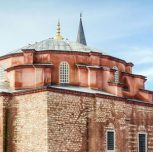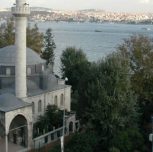Fethiye Mosque was originally built as a church in the Çarsamba neighborhood of the Fatih District by the Byzantine historian, Mihail Glabas Tarkaniotes, in the late 13the century. Its original location was on a hillside looking down over the Haliç (Golden Horn). After the conquest of Istanbul in 1453, the Orthodox Patriarchate was moved from the church and it was converted into a mosque to commemorate the conquest of Georgia and Azerbaijan in 1595. It was at this time that the mosque began to be called Fethiye Mosque. After it was converted into a mosque, the building’s abscissa was destroyed and a domed interior, a mihrab, a niche for the mosque, and a madrasa surrounding the courtyard along with minarets on three sides were added to the structure.
Fethiye Mosque underwent repaires in 1845, and an elementary school was built on the site of madrasa in the beginning of the 20th century. The complex’s structural integrity was also compromised by removing the outer wall of the forecourt. In addition, the mosque was later restored by the General Directorate of Religious Endowments between 1936 and 1938 and, after converting it into a museum, it was left under the administration of the Directorate of Museums. It was said that the Fethiye Mosque had been left rugged in that period, and it was reconverted into a mosque in the 1960s and the parekklesion situated next to the building was restored by the Byzantine Institute of America. During that restoration period, the mosaics and frescos in the parekklesion were revealed.










